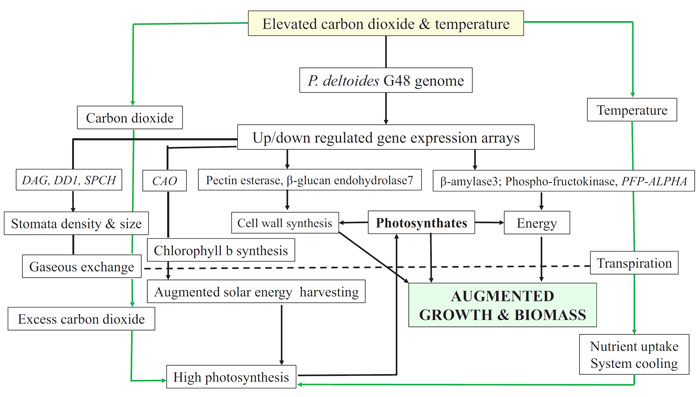| Tweet | Follow @co2science |
Paper Reviewed
Yadav, S.K., Singh, H., Nautiyal, R., Ginwal, H.S., Ansari, S.A. and Barthwal, S. 2020. Modulation of morpho-physiological responses in Populus deltoides by elevated carbon dioxide and temperature. Forest Science 66: 105-118.
Noting that plants exposed to elevated CO2 and temperature can considerably alter vegetative productivity and growth, Yadav et al. (2020) set out to determine how changes in these two abiotic parameters might alter the "growth, physiological processes, and gene expression for survival and adaptation" in eastern cottonwood (Populus deltoides) trees.
To accomplish this objective they exposed one-month-old fully developed homogenous rooted shoot cuttings of P. deltoides clone G48 to one of three CO2 and temperature treatments for a period of 180 days, at which time they conducted multiple morpho-physiological measurements and leaf transcriptome sequencing to evaluate the influence of these two parameters. The experiment was conducted in open-top chambers at the Forest Research Institute in Dehradun, India. The three treatments included (1) ambient CO2 and ambient temperature, (2) moderately-elevated CO2 and elevated temperature and (3) high CO2 and elevated temperature. Ambient CO2 was maintained at 400 ppm, moderate at 600 ppm and high at 800 ppm and elevated temperature was sustained at 4 °C above ambient conditions.
In summing up their findings at the conclusion of their paper, Yadav et al. write that "elevated CO2 and elevated temperature act as environmental cues for expression of upregulated/downregulated genes responsible for improving the photosynthetic apparatus and auxiliary process that alters stomatal density and size on both surfaces of leaves, facilitating solar-energy harvesting, photosynthetic CO2 assimilation, system cooling, and gaseous exchange," which processes are depicted in a flow chart in Figure 1. Continuing, they say the eastern cottonwood genome "responds in an integrated manner to capitalize on the excess CO2 resource on the one hand and insulate the biological system against the temperature rise on the other, ultimately paving the way for overall adaptability," which adaptability translated to observed increases in photosynthesis, stem diameter, root number, leaf length, petiole length, and leaf, root, stem and total biomass in the two elevated temperature and elevated CO2 treatments.
Commenting on these important findings, Yadav et al. write "our results emphatically demonstrate that P. deltoides G48 possesses genomic plasticity to adapt to the future projected increases in atmospheric CO2 concentration (800 ppm) and temperature (approximately 2.6-4.8 °C) by the end of the 21st century," which adaptation is "expected to improve stomatal density and size, chloroplast development, organization of photosynthetic apparatus, and efficient partitioning of photosynthates among different vital organs."

Figure 1. Flow chart explaining the authors' observed influence of elevated carbon dioxide and temperature on poplar (P. deltoids, cv. G48); CAO, chlorophyll A oxygenase; DAG, differentiation and greening; PFP-ALPHA, phosphofructokinase; SDD1, stomata density and distribution1-1; SPCH, speechless. The inner black line genomic pathway depicts action as an environmental cue for upregulated/downregulated gene expression mostly related to photosynthetic and auxiliary apparatus, and the outer green line the adaptive pathway for direct assimilation of elevated CO2 and neutralization of the elevated temperature effect. Source: Yadav et al. (2020).




